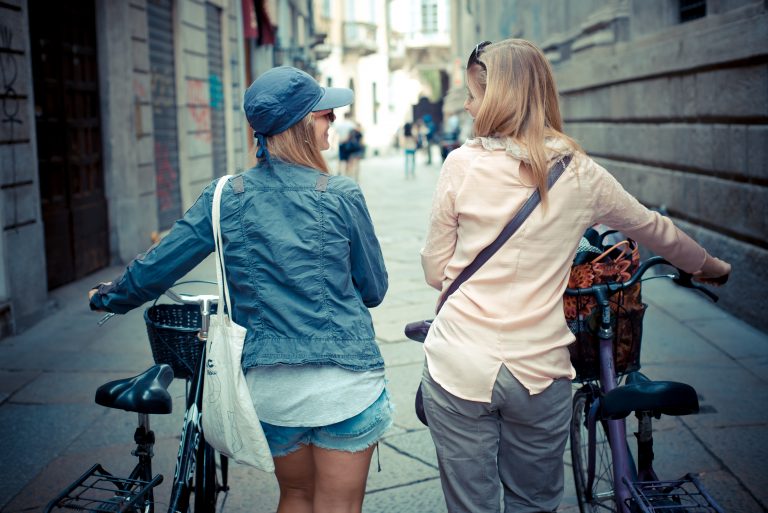
It is not only about transport: 5 ways in which biking helps our cities

The number of people that use the bike as a means of transport all over the world, and not as a sports tool, is constantly growing. Given that the bicycle is the most sustainable transport for short and medium distances, this is great news. This mode of transport is a testimony not only to the environment but also to the economic and social aspects of our cities. How exactly?
Many cities around the world are working nowadays to maintain the number of cyclists in the streets. When one asks why, you get a variety of answers: we are flooded by cars, we are inspired by other cities, and a pandemic has changed our habits. We find ourselves in a unique opportunity to transform our cities through biking and discover its huge social, economical and environmental potential for all its citizens. Why shouldn’t we waste this chance?
1. The use of bicycles leads to a longer, happier, and healthier life
The normal use of the bike as a way of moving from point A to B helps to prevent serious diseases like diabetes, certain types of cancer, heart diseases, and depression. It is also an effective way to prevent obesity. Regular biking increases physical condition, similar to 1 or 2 workouts a week. People who come and go to work by bike win on average 1,3 fewer sick leaves a year. Up to 75% of Dutch high school students go by bike to school every day, and it is not a coincidence that, according to UNICEF, Dutch teens are among the healthiest and happiest in the world. Moreover, they have the lowest numbers of obesity and depression. These are very interesting results too, given that one among six Europeans is currently struggling with their mental health.

Dutch kids are healthy and happy. Guess why…
2. Bicycles boost the comfort and mobility of millions of people
Riding a bike is easy and fun, it is an activity associated with happy feelings. People commuting to work on foot or by bike are happier, less stressed, and more relaxed than car drivers. According to another study, the bike also benefits older people’s mental health, that is, it increases their quality of life. It also fosters social interactions, because by bike you need to monitor what is happening around you and adapt accordingly. Moreover, we cannot forget it is a comfortable and healthy way of going from point A to B. For millions of people in the world, biking means accessing education, work, or medical care which in other ways would not be available. For them, a bike is literally a “freedom machine” and a path to a better life.
3. Also equality and a sense of community
When brought access to the latter, we create stronger and safer communities. In the bicycle seat, everyone is more or less equal and closer to each other. Intelligent infrastructure brings more safe public space for the people who really begin to live it and take care of it. Streets stop being an anonymous jungle, to become true living spaces. Consequently, should guarantee that all people, whether they are 5 or 85 years old, could ride a bike safely and comfortably.

Cycling brings people closer to each other
4. The bike is good for the environment
Although it seems obvious, let’s summarize it to complete it. Even small changes can have big impacts. Everybody knows that climate change, or if you want climate collapse, will affect all of us. What can we do as individuals? The International Panel for Climate Change (IPCC) has a simple recommendation: we need more cycling. And then there is air pollution, which is responsible for the death of nine million people a year. This, along with the noise and soil and water pollution, can be reduced with the help of bikes. Cyclists also occupy less space than cars, and the construction of infrastructure for them (and pedestrians) accelerates the public transport flux. This, at the same time, leads to the reduction of 45% of car traffic.
5. Economy benefits from it too
Aside from the higher productivity obtained by having fewer sick leaves, companies that support their employees in cycling attract motivated, creative and productive people with goals. The same thing applies to cities and municipalities. A study done in Great Britain showed that non-motorists earn 40% more in local businesses. The philosophy of a town hall is like its DNA, and if deputies begin to move in non-motorized transport, the place´s genetics will change too. This is followed by an emphasis on the sustainable and circular economy, which mainly takes place on a local level.

A good cyclist infrastructure strengthens and improves the flux on public transport
This way, we see that bicycles help solve the problems that most cities face nowadays. But until now, no other place on the planet has been able to make that potential into reality. Nevertheless, the good news is that, in some way, we are increasingly conscious of the fact that the bike is far from being only a transportation matter; it is a whole transformation. And when cities reflect and make it true, we all will be beneficiaries.

The theme of this year’s May Challenge is the Path to Balance

I wanted the motif to evoke playfulness, says the author of the visual for this year’s May Challenge
